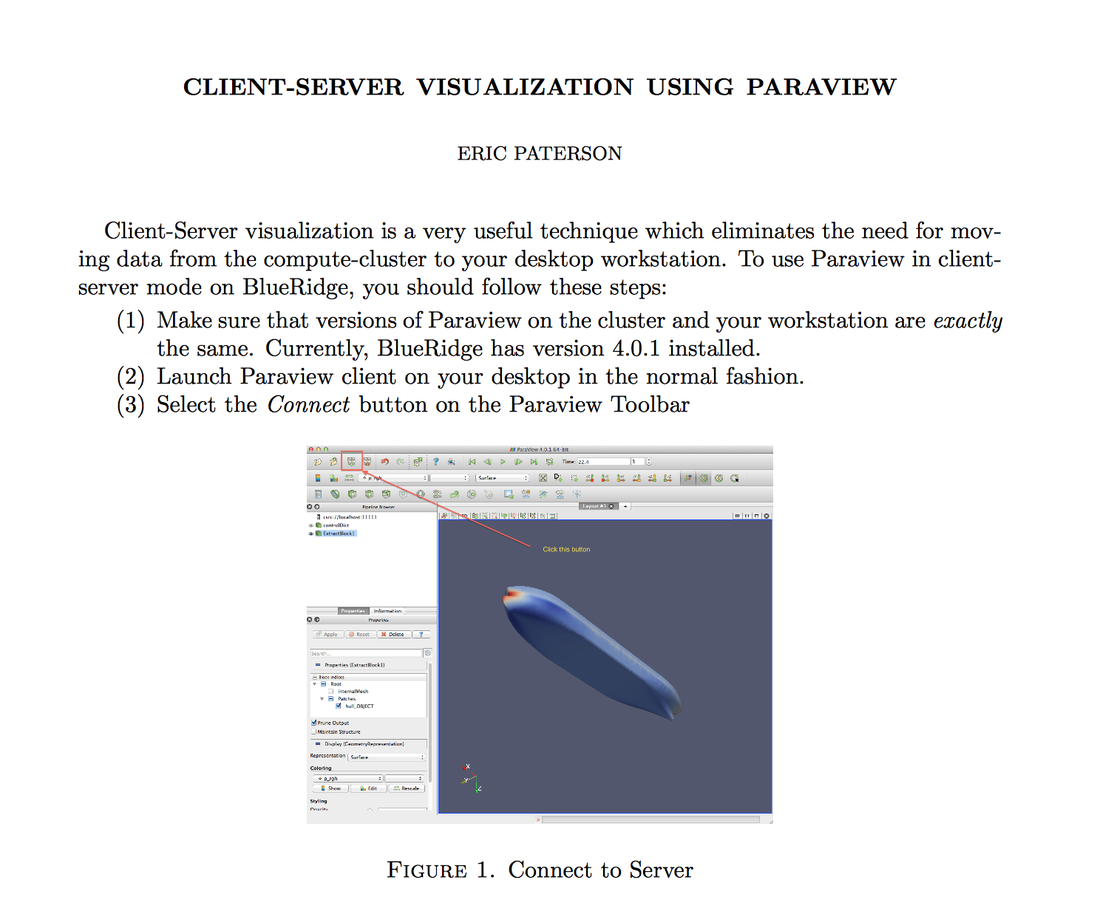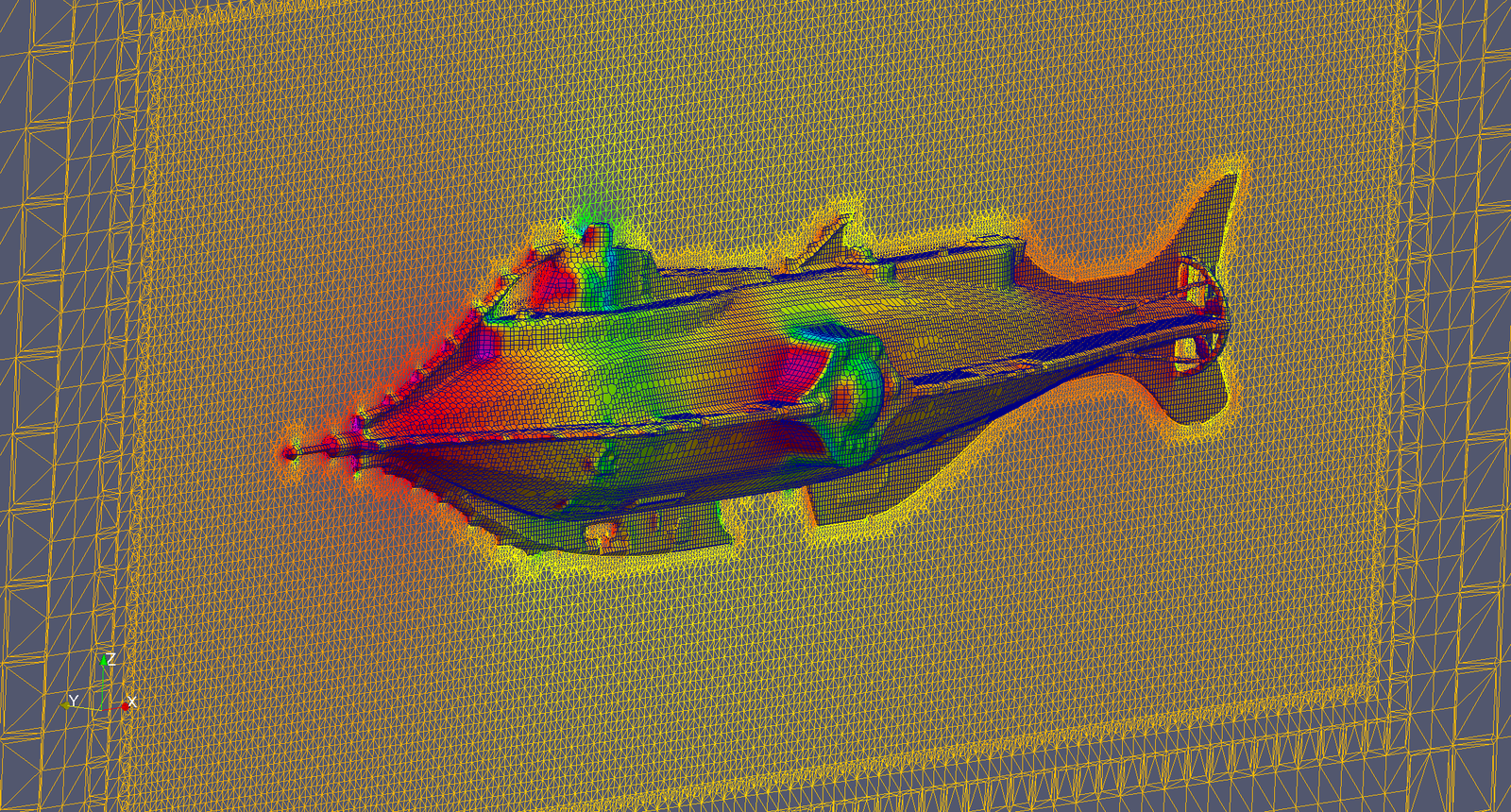AOE 5984: Introduction to Parallel Computing Applications
OpenFOAM for CFD Applications
Lecture 3: Data Analysis and Visualization
Professor Eric Paterson
Aerospace and Ocean Engineering, Virginia Tech
19 November 2013
Topics briefly discussed in Lecture 2
- Introduction to OpenFOAM data analysis tools
- Showed dictionary entries used by the sample utility for extracting sets and surfaces data from 4D fields
- Showed example of plotting X-Y data (sets) with python+matplotlib
- Showed example of visualizing surfaces rather than loading entire datasets
- Emphasized that data reconstruction should be avoided
Lecture 3: Data Analysis & Visualization
- Highlight the difference between data analysis and visualization of OpenFOAM data
- Discuss utilities and post-processing software for data analysis and visualization
- Students will:
- appreciate the importance of working with decomposed and remote data
- understand that there are numerous OpenFOAM utilities for operating on data and computing derived data
- learn about the power of using python and pyFoam
- understand that client-server visualization is important for reducing data transfer and duplication
Data Analysis vs. Visualization
- Data Analysis
- Quantitative
- Primary and derived variables
- Integral variables, e.g., lift, drag, mass-flow rate
- X-Y plots
- Extraction of comparison metrics for verification and validation
- Visualization
- Qualitative
- Primary and derived variables
- Contour maps, streamlines, iso-surfaces, etc.
- Animations
OpenFOAM utilities
- OpenFOAM has numerous pre-compiled post-processing utilities, which can be found in $FOAM_UTILITIES/postProcessing
- Description of each can be found online at: http://www.openfoam.org/docs/user/standard-utilities.php
- Many of the utilities perform vector and tensor operations to compute derived variables, e.g., vorticity, Q, lambda2, shearStress, etc.
velocityField postProcessing tools
Post-processing velocity fields | |
Calculates and writes the Courant number obtained from field phi as avolScalarField. |
|
Calculates and writes the enstrophy of the velocity field U |
|
Calculates and writes the flowType of velocity field U |
|
Calculates and writes the second largest eigenvalue of the sum of the square of the symmetrical and anti-symmetrical parts of the velocity gradient tensor |
|
Calculates and optionally writes the local Mach number from the velocity field U at each time |
|
Calculates and writes the Pe number as a surfaceScalarField obtained from field phi |
|
Calculates and writes the second invariant of the velocity gradient tensor |
|
Calculates and writes the stream function of velocity field U at each time |
|
Calculates and writes the scalar field of uprime ( |
|
Calculates and writes the vorticity of velocity field U |
|
Example: Calculation of vorticity
postProcessing/velocityField/vorticity/vorticity.C
IOobject Uheader
(
"U",
runTime.timeName(),
mesh,
IOobject::MUST_READ
);
if (Uheader.headerOk())
{
Info<< " Reading U" << endl;
volVectorField U(Uheader, mesh);
Info<< " Calculating vorticity" << endl;
volVectorField vorticity
(
IOobject
(
"vorticity",
runTime.timeName(),
mesh,
IOobject::NO_READ
),
fvc::curl(U)
);
volScalarField magVorticity
(
IOobject
(
"magVorticity",
runTime.timeName(),
mesh,
IOobject::NO_READ
),
mag(vorticity)
);
Info<< "vorticity max/min : "
<< max(magVorticity).value() << " "
<< min(magVorticity).value() << endl;
if (writeResults)
{
vorticity.write();
magVorticity.write();
}
}
else
{
Info<< " No U" << endl;
} wall postProcessing tools

Example: calculation of
wallShearStress
void calcIncompressible
(
const fvMesh& mesh,
const Time& runTime,
const volVectorField& U,
volVectorField& wallShearStress
)
{
#include "createPhi.H"
singlePhaseTransportModel laminarTransport(U, phi);
autoPtr<:rasmodel> model
(
incompressible::RASModel::New(U, phi, laminarTransport)
);
const volSymmTensorField Reff(model->devReff());
forAll(wallShearStress.boundaryField(), patchI)
{
wallShearStress.boundaryField()[patchI] =
(
-mesh.Sf().boundaryField()[patchI]
/mesh.magSf().boundaryField()[patchI]
) & Reff.boundaryField()[patchI];
}
} where is the function devReff?

tmp kEpsilon::devReff() const
{
return tmp
(
new volSymmTensorField
(
IOobject
(
"devRhoReff",
runTime_.timeName(),
mesh_,
IOobject::NO_READ,
IOobject::NO_WRITE
),
-nuEff()*dev(twoSymm(fvc::grad(U_)))
)
);
} 
python
- How to plot X-Y data for quantitative analysis?
- Tecplot
- Matlab
- python + matplotlib + numpy + scipy
- interactive python ipython provides a shell interface, http://ipython.org
- Visualization tools use python scripting for data manipulation and automation, http://paraview.org/Wiki/ParaView/Python_Scripting
pyFoam

pyFoam
-
This Python-library can be used to
- analyze the logs produced by OpenFoam-solvers
- execute OpenFoam-solvers and utilities and analyze their output simultaneously
- manipulate the parameter files and the initial-conditions of a run in a non-destructive manner
- plots the residuals of OpenFOAM solvers
-
Written by Bernhard Gschaider
pyFoam example

Visualization
- There are many very good visualization software packages
- Paraview - free
- Tecplot - Virginia Tech site license
- Fieldview
- Ensight
- All of these packages natively read OpenFOAM data, plus numerous other formats
- Making useful images requires experience and an eye for esthetics and art: beware of chartjunk and colorful fluid dynamics
Wind-turbine interaction: Fieldview

client-server visualization walkthrough

 )
)